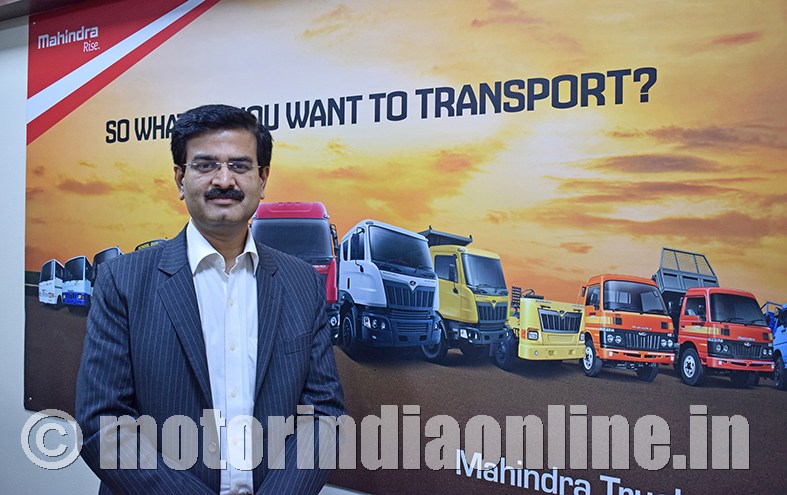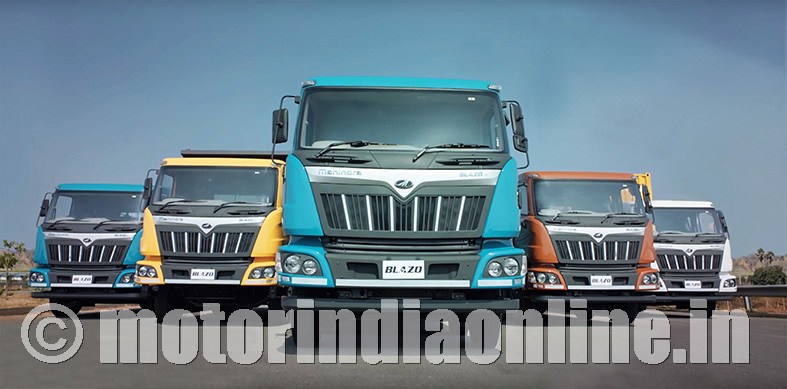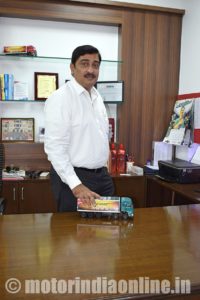The Mahindra Truck and Bus Division (MTBD) has taken out performance to the next level by producing trucks that are specifically designed for different applications and to deliver results, whatever be the business needs. Now, the industry is undergoing transition from BS-III to BS-IV. In the words of Mr. Vinod K. Sahay, CEO Designate, MTBD, “it marks the dawn of a new era in the industry.” He lays down four points to stress why fleet operators must make an important choice at this juncture.

The first aspect is that all truck manufacturers will have to mandatorily adopt mechanical engines. Mr. Sahay states: “We had mechanical engines for a long time, and now all the OEMs will also have to adopt mechanical engines. Second, to meet the emission requirement whichever technology companies adopt, they will have to go through some after-treatment, which only keeps increasing as the industry is moving towards BS-VI. The moment you have after-treatment it puts a back pressure on the engine which reduces its declared capacity in terms of retreat. So, the world over when people have moved from Euro IV onwards or in India from BS-IV, it is time for larger engines. The smaller engines (especially 5.5 ltr to 6 ltr engines for HCVs) in our view is not sufficient for the transition for the heavy trucks and fleet operators must be careful about that. We are offering SCR technology with the highest torque with 7.2 litre mPower engine.”
GST impact
Another important change that the industry will deal with relates to GST. It is because of GST that the inter-State transport is becoming efficient and trucks are reportedly showing faster turnaround time. In such a scenario, when fleet utilization improves, larger engines that can deliver maximum output will be needed. “Trucks which were earlier doing 7-8 thousand km per month are now doing 10-12 thousand km. So, the average running of the truck which was up to 96,000 km a year may go up to 1,20,000 km to 1,40,000 km.” Thus, larger engines with significant reserve power will be able to provide the run required for the trucks, claims Mr. Sahay.
The fourth interesting point that Mr. Sahay highlighted, which fleet operators need to keep in mind, is the BS-IV regime with its stipulation that all vehicle manufacturers, including us, will launch their BS-VI trucks around December 2019. Unlike BS-I, II, III trucks that were produced for 8-10 years, the BS-IV window is too small. Fleet operators must factor in what will happen to the trucks once BS-VI trucks enter the market. They must figure out what changes manufacturers are going to bring about when they migrate to the next emission levels. We are telling our customers that ours will be the same engine when we will move to BS-VI as it is a powerful 7.2 ltrs multi-mode fuel smart CRDi engine, which may not be the case with many who are using smaller size engines.”
He added: “People who have made significant changes from mechanical to electronic and then change to a new engine during BS-VI, the concern related to spare parts availability and the resale value of these trucks is something that should bother people. Hence the customer should make a right decision at this juncture of changing technology.”
Strategy and outlook
From the Mahindra point of view, from BS-III to BS-IV truck, their promises regarding fuel efficiency remain the same, factoring even the AdBlue. “We are still giving the mileage guarantee if our truck doesn’t give fuel fluid economy including ADBlue cost in it then we are ready to take back the truck. We also continue the spare parts guarantee that if the fast-moving parts are not available in our MParts plaza then we will give the parts free to the customer. On the Delhi-Mumbai service corridor if we are not able to provide assistance within two hours we will give hourly compensation and the same guarantee we will extend to some other routes.” As a package MTBD is strongly propagating that from BS-IV regime and forward their trucks are the best available options.
Asked about the performance of the Blazo range of trucks, Mr. Sahay observed: “We are improving our standings, and being a challenger brand, we are number four with a substantial difference between us and the next player. We didn’t have a single truck back despite the ‘return truck back’ guarantee. This is testimony of our outperformance.”
BS-IV operating economics
Except for some 7-8 unique parts added to the BS-IV engine, the Blazo engine has remained the same. Explaining the operating economics of the Blazo range Mr. Sahay elaborated: “The cost of Blazo BS-IV from BS-III has increased only by Rs. 7,200 over a four-year period, which is around Rs. 2,400 per annum or slightly less. We are giving fluid economy guarantee with BS-IV or taking the truck back. In our internal test trials and some of our customer’s test reports has proved that BS-IV Blazo is giving at least five per cent better fluid efficiency than any other BS-IV competitors truck.”
There is an unnecessary fear among market circles that if the AdBlue is over, while on road the truck may stop moving. Here Mr. Sahay said: “Even if the Adblue finishes we have a system that the truck doesn’t stop working or goes into a torque-truncated mode. When the Adblue is over for the next 48 hours the driver has the same power output till it goes to a 40 per cent less torque which he used to have earlier and 48 hrs is like 2000 km. So, a driver not getting Adblue for 2000 km is a little far-fetched thought in India.”
Post-BS IV there is a lot of debate over exhaust gas recirculation (EGR) or selective catalytic reduction (SCR) options. Many believe that EGR is a technology to be used up to light commercial vehicles (LCVs) and may be even intermediate commercial vehicles (ICVs). However, having heavy commercial vehicles (HCVs) in EGR might cause problems. Dr. Venkat Srinivas, Principal Chief Engineer and Head – Product Development, Mahindra & Mahindra Ltd; Truck & Bus Division, explained: “SCR is the right option for HCVs because the power to weight ratio is much lower in HCVs compared to LCV trucks or passenger vehicles. If you take a 49 tonner HCV truck the power to weight ratio is around 4.5, whereas for a 5 tonner LCV vehicle the similar power to weight ratio is about 14. This means an HCV vehicle operates at a full load most of the time compared to an LCV vehicle, which means the engine is stressed more in an HCV and EGR is therefore not good for that type of application.”
He added: “EGR reduces the fresh air fluid mixer that goes into the engine and it mixes it up with exhaust gas recirculation. About 15-18 per cent of exhaust gases are recirculated into the engine combustion cycle. Fresh air fuel mixture that the engine is getting is that much lower. Therefore, we believe EGR is not the right technology for HCVs and putting EGR will compromises the life of the engine.”
MTBD will thus offer the SCR technology with the highest torque on the 7.2 litre mPower engine. “We are giving a 950 nm of torque compared to 850 nm or lower than the competition. Our reserve torque can handle applications for any load and terrain combination, that some of our competition might not have,” asserted Dr. Srinivas.
MTBD’s SCR technology will be an airless one and, as claimed by Dr. Srinivas, will be the only OEM in India to offer it. “The airless SCR is a new generation technology (next generation) compared to air assisted. It is more efficient, and it has less parts so it takes less power to run the airless system and gives better performance. The system is easily serviceable compared to the air-assisted technology. This forms the core of our architecture as we go from BS-III to BS-IV,” beamed Dr. Srinivas.
Steady growth
MTBD’s Blazo range of HCV products has been engineered for Indian requirements with the underlying philosophy of “Made in India, Made for India”. In the HCV segment, MTBD already has reached more than 25,000 trucks on road. The company is in the process of addressing every segment of the commercial vehicle market, from 3.5 tonne GVW to 49 tonne GVW, with variants that meet the varying needs of passenger transport, cargo and specialized load applications.
It is all set to further strengthen its position across India in the LCV segment with over 150,000 vehicles already on the road. The entire range of LCVs and buses are manufactured at M&M’s Zaheerabad facility. “The making of ICV platforms is already at an advanced stage of validation and homologation and the launch dates will be announced soon,” said Dr. Srinivas.
The company also has rapidly expanded its aftersales service and spares network which now has 82 3S dealerships, 120 authorized service centers and 2,900 roadside assistance points. The spares network of 2,069 retail outlets will further improve the reach of support for customers on important trucking routes. It also boasts of India’s first multi-lingual helpline, NOW, which is manned by technical experts to provide instant support to customers. The NOW mobile service vans and mobile workshops further add to the reach and agility of the support network.
Mahindra was also the first company to offer 5 years or 5 lakh km transferable warranty in the Indian trucking industry. A three-pronged strategy will certainly put them at par with the competition in years to come.
Dr. Venkat Srinivas, Principal Chief Engineer and Head – Product Development, Mahindra & Mahindra Ltd; Truck & Bus Division
SCR is the right option for HCVs because the power to weight ratio is much lower in HCVs compared to LCV trucks or passenger vehicles. If you take a 49 tonner HCV truck the power to weight ratio is around 4.5, whereas for a 5 tonner LCV vehicle the similar power to weight ratio is about 14. This means an HCV vehicle operates at a full load most of the time compared to an LCV vehicle, which means the engine is stressed more in an HCV and EGR is therefore not good for that type of application.

